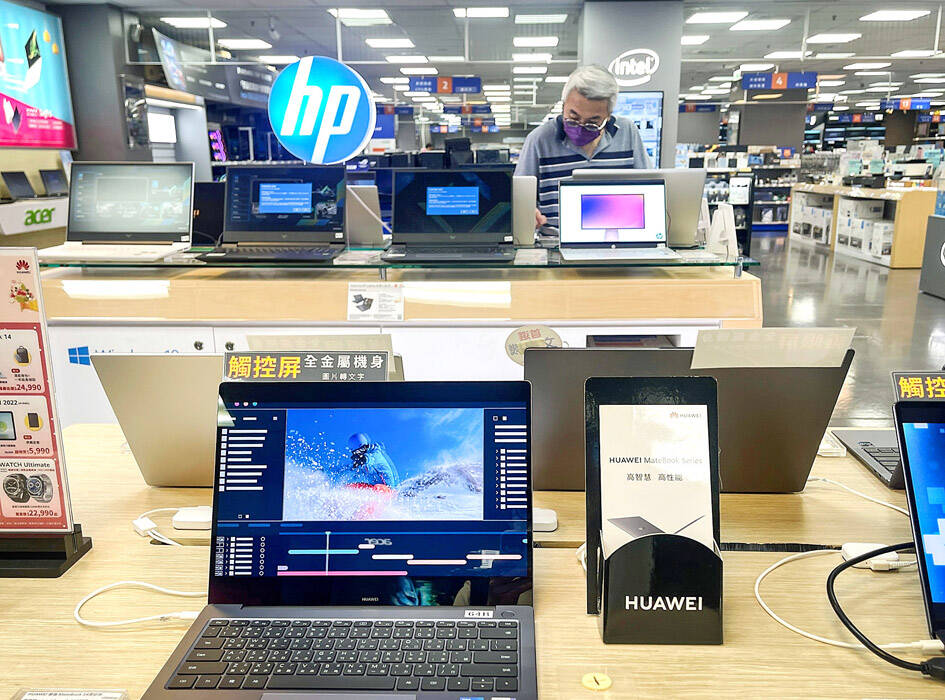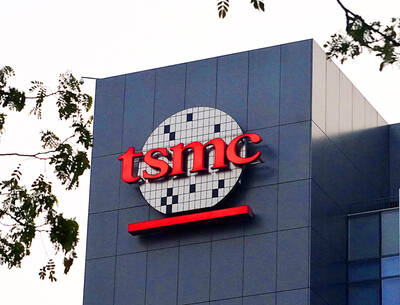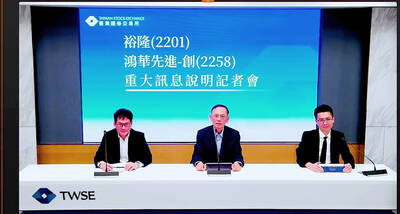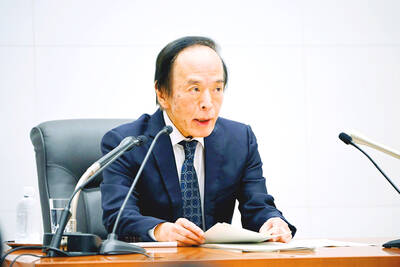The business climate monitor for the manufacturing industry turned “blue” in March, from a revised “yellow-blue” in February, as demand, selling prices and operating conditions weakened, the Taiwan Institute of Economic Research (TIER, 台灣經濟研究院) said yesterday.
The business composite index compiled by the Taipei-based think tank shed 0.56 points to 10.41, reflecting listless manufacturing activity, as global clients continued to adjust inventory amid poor sales.
TIER uses a five-color spectrum to capture the industry’s movements, with “red” indicating a boom, “green” suggesting steady growth and “blue” signifying a downturn. Dual colors indicate a transition to a better or worse condition.

Photo: CNA
Taiwan is home to the world’s leading suppliers of electronics used in smartphones, personal computers, wearables, TVs, vehicles and cloud computing.
A majority of local manufacturers, 51.75 percent, reported a decline in business, while 35.51 percent experienced a soft patch and 12.16 percent held steady, the institute’s monthly survey found.
None experienced a boom, it added.
The findings came even though firms in Taiwan and Asia emerged unscathed from bank failures in the US and Europe, TIER said.
The cost and input readings gained a meager 0.17 and 0.07 points respectively after the global economic slowdown cooled raw material prices and eased cost burdens, the institute said.
However, the gauges for demand, selling prices and overall operating conditions declined further, as inventory corrections dragged on, prompting local manufacturers to cut capacity to protect their margins.
For instance, petrochemical product suppliers opted to conduct annual equipment maintenance after outbound shipments and orders tumbled more than 30 percent from a year earlier, TIER said.
Plastic and rubber product makers saw business shrinking by a similar amount, despite the peak season starting, the institute said.
Tepid market demand in the US and Europe was to blame, but China added to the problem by cutting its dependence on one-off plastic products, it said.
Makers of textile products, while benefiting from rush orders in the wake of China’s reopening, saw sharper declines in production and business orders, as apparel brands turned conservative about inventory, it said.
Paper product vendors had a mixed showing, as a recovery in tourism and commerce boosted demand for shopping and packaging bags, but paper products for industrial use floundered, the institute said.
Vehicle sales picked up after chip shortages came to an end, enabling local suppliers of auto parts to report steady business growth, it said.

Taiwan’s long-term economic competitiveness will hinge not only on national champions like Taiwan Semiconductor Manufacturing Co. (TSMC, 台積電) but also on the widespread adoption of artificial intelligence (AI) and other emerging technologies, a US-based scholar has said. At a lecture in Taipei on Tuesday, Jeffrey Ding, assistant professor of political science at the George Washington University and author of "Technology and the Rise of Great Powers," argued that historical experience shows that general-purpose technologies (GPTs) — such as electricity, computers and now AI — shape long-term economic advantages through their diffusion across the broader economy. "What really matters is not who pioneers

In a high-security Shenzhen laboratory, Chinese scientists have built what Washington has spent years trying to prevent: a prototype of a machine capable of producing the cutting-edge semiconductor chips that power artificial intelligence (AI), smartphones and weapons central to Western military dominance, Reuters has learned. Completed early this year and undergoing testing, the prototype fills nearly an entire factory floor. It was built by a team of former engineers from Dutch semiconductor giant ASML who reverse-engineered the company’s extreme ultraviolet lithography (EUV) machines, according to two people with knowledge of the project. EUV machines sit at the heart of a technological Cold

TAIWAN VALUE CHAIN: Foxtron is to fully own Luxgen following the transaction and it plans to launch a new electric model, the Foxtron Bria, in Taiwan next year Yulon Motor Co (裕隆汽車) yesterday said that its board of directors approved the disposal of its electric vehicle (EV) unit, Luxgen Motor Co (納智捷汽車), to Foxtron Vehicle Technologies Co (鴻華先進) for NT$787.6 million (US$24.98 million). Foxtron, a half-half joint venture between Yulon affiliate Hua-Chuang Automobile Information Technical Center Co (華創車電) and Hon Hai Precision Industry Co (鴻海精密), expects to wrap up the deal in the first quarter of next year. Foxtron would fully own Luxgen following the transaction, including five car distributing companies, outlets and all employees. The deal is subject to the approval of the Fair Trade Commission, Foxtron said. “Foxtron will be

INFLATION CONSIDERATION: The BOJ governor said that it would ‘keep making appropriate decisions’ and would adjust depending on the economy and prices The Bank of Japan (BOJ) yesterday raised its benchmark interest rate to the highest in 30 years and said more increases are in the pipeline if conditions allow, in a sign of growing conviction that it can attain the stable inflation target it has pursued for more than a decade. Bank of Japan Governor Kazuo Ueda’s policy board increased the rate by 0.2 percentage points to 0.75 percent, in a unanimous decision, the bank said in a statement. The central bank cited the rising likelihood of its economic outlook being realized. The rate change was expected by all 50 economists surveyed by Bloomberg. The